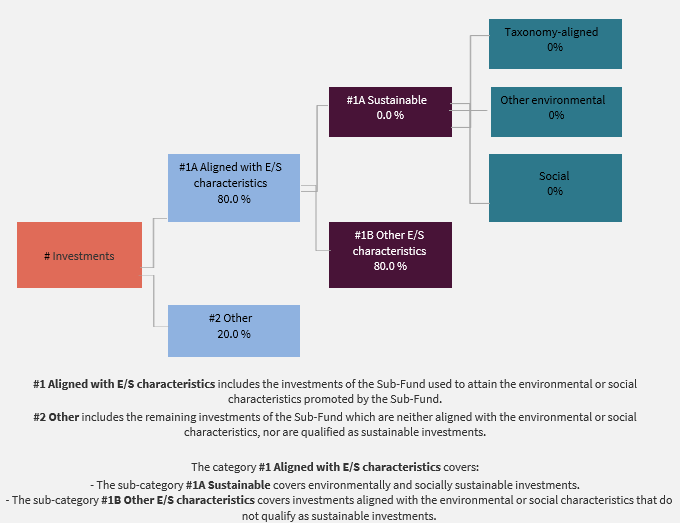AXA Investment Management
Sustainability Disclosure Reporting | 2022-12-20
This document provides disclosure requirements according to Article 10 of Regulation (EU) 2019/2088, for the Sub-Funds referred to in Article 8 of the Regulation
Product name: AMX - AXA IM - Single Investor Long Term Credit
Legal entity identifier: 6354004PFD6WKSLDLP51
Summary
Environmental or Social characteristic promoted by the Sub-Fund
The AMX - AXA IM - Single Investor Long Term Credit Fund (the “Sub-Fund”) is categorised as an Article 8 product under the Sustainable Finance Disclosure Regulation (“SFDR”). The environmental and social characteristics promoted by the Sub-Fund consist of investing in companies considering their Environment, Social and Governance (“ESG”) scores, as further described below. This Sub-Fund promotes environmental or social characteristics but does not have as its objective sustainable investment.
The Sub-Fund also promotes other specific environmental and social characteristics, mainly:
- Preservation of climate with exclusion policies on coal and oil sand activities
- Protection of ecosystem and prevention of deforestation
- Better health with exclusion on tobacco
- Labor rights, society and human rights, business ethics, anti-corruption with exclusion on companies in violation of international norms and standards such as the United Nations Global Compact Principles, International Labor Organization’s (ILO) Conventions or the OECD guidelines for Multinational Enterprises.
No reference benchmark has been designated for the purpose of attaining the environmental or social characteristics promoted by this Sub-Fund.
AXA IM also applies specific policy to ensure good governance practices of investee companies.
Asset allocation planned for the Sub-Fund
The planned minimum proportion of the investments of the Sub-Fund used to meet the environmental or social characteristics promoted by the Sub-Fund is 80.0 % of the Sub-Fund Net Asset value.
The planned minimum proportion of sustainable investments of the Sub-Fund where that Sub-Funds commits to making sustainable investments is 0.0 % of the Sub-Fund Net Asset Value.
The remaining “Other” investments will represent a maximum of 20% of the Sub-Fund Net Asset Value.
Sub-Fund’s investment strategy
The Sub-Fund’s objective is to seek to access credit premium and to seek to assist with the management of the Sub-Fund’s risk by investing in a diversified portfolio of fixed income securities in an efficient manner that will, over the life of the Sub-Fund, broadly seek to deliver and distribute cashflows by way of income and/or principal repayments on those securities.
The Portfolio Manager selects investments by applying an extra-financial approach by defining the eligible universe after application of the exclusion filters as described in AXA IM's Sectorial Exclusion Policy/ies and AXA IM’s ESG Standards Policy.
The Sub-Fund bindingly applies at all times the following elements described below.
1. The Portfolio Manager bindingly applies at all times a first exclusion filter, encompassing areas such as Controversial Weapons, Climate risks, Soft Commodities and Ecosystem Protection & Deforestation. The Sub-Fund also applies AXA IM’s ESG Standards Policy, integrating the ESG Standards Policy in the investment process by applying specific sectorial exclusions such as tobacco and white phosphorus weapons and by excluding investments in securities issued by companies in violation of international norms and standards such as the United Nations Global Compact Principles or the OECD guidelines for Multinational Enterprises; as well as investments in companies which are involved in severe ESG-related incidents and investments in issuers with a Low ESG quality (which is, as of the date of this Prospectus, below 1.43 (on a scale of 0 to 10) – such number being subject to regular review and adaptation). Instruments issued by countries where serious specific categories of violations of Human Rights are observed are also banned.
More details and information are presented in the Sub-Fund’s website disclosures and in its SFDR precontractual annex notably on AXA IM's SFDR sustainability framework, minimum asset allocation planned by the Sub-Fund, monitoring of environmental or social characteristics promoted, underlying data and due diligence.
No sustainable investment objective
This Sub-Fund promotes environmental or social characteristics but does not have as its objective sustainable investment.
Environmental or social characteristics of the Sub-Fund
The environmental and social characteristics promoted by the Sub-Fund consist of investing in companies considering their Environment, Social and Governance (“ESG”) scores, as further described below.
The attainment of the promotion of environmental or social characteristics is measured using ESG Score as a sustainability indicator. The binding elements of the investment strategy that are applied at all times are listed below.
The Sub-Fund also promotes other specific environmental and social characteristics, mainly:
- Preservation of climate with exclusion policies on coal and oil sand activities
- Protection of ecosystem and prevention of deforestation
- Better health with exclusion on tobacco
- Labor rights, society and human rights, business ethics, anti-corruption with exclusion on companies in violation of international norms and standards such as the United Nations Global Compact Principles, International Labor Organization’s (ILO) Conventions or the OECD guidelines for Multinational Enterprises.
No reference benchmark has been designated for the purpose of attaining the environmental or social characteristics promoted by this Sub-Fund.
Investment strategy
The Sub-Fund bindingly applies at all times the following elements described below.
1. The Portfolio Manager bindingly applies at all times a first exclusion filter, encompassing areas such as Controversial Weapons, Climate risks, Soft Commodities and Ecosystem Protection & Deforestation. The Sub-Fund also applies AXA IM’s ESG Standards Policy, integrating the ESG Standards Policy in the investment process by applying specific sectorial exclusions such as tobacco and white phosphorus weapons and by excluding investments in securities issued by companies in violation of international norms and standards such as the United Nations Global Compact Principles or the OECD guidelines for Multinational Enterprises; as well as investments in companies which are involved in severe ESG-related incidents and investments in issuers with a Low ESG quality (which is, as of the date of this Prospectus, below 1.43 (on a scale of 0 to 10) – such number being subject to regular review and adaptation). Instruments issued by countries where serious specific categories of violations of Human Rights are observed are also banned.
The ESG data used in the investment process are based on ESG methodologies which rely in part on third party data, and in some cases are internally developed. They are subjective and may change over time. Despite several initiatives, the lack of harmonised definitions can make ESG criteria heterogeneous. As such, the different investment strategies that use ESG criteria and ESG reporting are difficult to compare with each other. Strategies that incorporate ESG criteria and those that incorporate sustainable development criteria may use ESG data that appear similar but which should be distinguished because their calculation method may be different. AXA IM’s different ESG methodologies described herein may evolve in the future to take into account any improvements in data availability and reliability, or any developments of regulations or other external frameworks or initiatives, amongst others.
The Sub-Fund does not invest in companies which cause, contribute to or are linked to violations of international norms and standards in a material manner. These standards focus on Human Rights, Society, Labor and Environment. AXA IM relies on an external provider’s screening framework and excludes any companies that have been assessed as “non compliant” to the UN’s Global Compact Principles, International Labor Organization’s (ILO) Conventions, OECD Guidelines for Multinational Enterprises and the UN Guiding Principles on Business and Human Rights (UNGPs).
In addition, ensuring good governance practices is also addressed by the engagement policies. AXA IM implements a comprehensive active ownership strategy – engagement and voting – where AXA IM acts as stewards of investments made on its clients' and investors’ behalves. AXA IM views engagement as a means for clients and investors to influence, shape and shift investee company policies and practices to mitigate risks and secure long-term value. Governance practices of companies are engaged at first level by the portfolio managers and dedicated ESG analysts when meeting with companies’ management teams. It is by virtue of its long-term investor status and in-depth knowledge of the investment targets that AXA IM feels it is legitimate to engage in a constructive but demanding dialogue with them.
Proportion of investments

The Sub-Fund aims to plan its assets’ allocation as presented in the graph above. This planned asset allocation might deviate on a temporary basis.
The planned minimum proportion of the investments of the Sub-Fund used to meet the environmental or social characteristics promoted by the Sub-Fund is 80.0 % of the Sub-Fund Net Asset value.
The planned minimum proportion of sustainable investments of the Sub-Fund where that Sub-Funds commits to making sustainable investments is 0.0 % of the Sub-Fund Net Asset Value.
The remaining “Other” investments will represent a maximum of 20% of the Sub-Fund Net Asset Value.
The “other” assets may consist in:
- cash and cash equivalent investments being bank deposit, eligible money market instruments and money market funds used for managing the liquidity of the Sub-Fund, and
- other instruments eligible to the Sub-Fund and that do not meet the Environmental and/or Social criteria described in this appendix. Such assets may be transferable debt securities, derivatives investments and investment collective schemes that do not promote environmental or social characteristics and that are used to attain the financial objective of the Sub-Fund and/or for diversification and/or hedging purposes.
Environmental or social safeguards are applied and assessed on all “other” assets except on (i) non single name derivatives, (ii) on UCITS and/or UCIs managed by other management company and (iii) on cash and cash equivalent investments described above.
Monitoring of environmental or social characteristics
The environmental and social characteristics promoted by the Sub-Fund are reflected in monitoring tool and monitored by AXA IM Risk and Control team at all times through the ban-lists established by AXA IM RI Research team on each exclusion policy described above. Ban-lists are built based on criteria defined in AXA IM policies that are presented under the following link: https://www.axa-im.com/our-policies-and-reports. The exclusion list is updated on an annual basis unless a specific event requires an intermediate revision or a delay in the publication of data from AXA IM sources which may postpone the update. Any updates are approved by dedicated governance body.
The sustainability indicator is reported to investment team in a specific report.
Methodologies for environmental or social characteristics
The attainment of the environmental and social characteristics promoted by the Sub-Fund and described above is measured with the following sustainability indicator:
- The weighted average ESG score of the Sub-Fund.
The ESG score is based on ESG scoring from an external data provider as primary inputs assessing data points across ESG dimensions. ESG scores are calculated by considering factors such as, but not limited to, carbon emissions, Health & Safety and Corporate Governance. The weight given to each ESG factor depends on the specific industry that the issuer is in. AXA Portfolio Managers UK Limited (“AXA IM” or the “Portfolio Manager”) analysts can complement this with a fundamental and documented ESG analysis in case of lack of coverage or disagreement on the ESG rating, provided that it is approved by an AXA IM dedicated internal governance body.
Data sources and processing
The AXA IM sectorial and ESG Standards’ ban-lists are prepared using information from external data providers. Data providers used to define those exclusion lists are detailed at the following link: https://www.axa-im.com/our-policies-and-reports. Ban lists are prepared and updated by AXA IM Responsible Investment Research team and approved by a dedicated governance body.
The ESG Scores rely on an external data provider (MSCI) coupled with an overlay of AXA IM’s own fundamental and documented ESG analysis. The proportion of data that are estimated is considered as being in the high range. Those ESG analysis are reviewed and approved in a dedicated governance body, the ESG Assessment and Review Committee.
The ESG Score sustainability indicator is relying on an external data provider MSCI. These data are updated at least on a bi-annual basis. The proportion of data that are estimated is considered as being in the high range.
AXA IM may change third party data providers at any time and at its own discretion and this may lead to changes to the data used for the same instruments or investments in the future.
AXA IM has been working with ESG data providers for several years and performs a due diligence on the methodology and outputs when selecting them. To make the best possible choices, the strengths and weaknesses of each data provider were reviewed and compared to determine factors such as coverage, data quality, alignment with sustainability-related regulations, calculation methodologies and level of transparency on these methodologies, update frequency and cost. When selected, AXA IM also performs regular checks on such external data providers. Regarding ESG scores and Sustainable Investment methodology in particular, each refresh of data is subject to a review as per our internal governance with an involvement from the risk department, quantitative experts and investment teams.
Data is received generally from automated data feeds. Values are cascaded to relevant associated issuers or securities and are then processed to aggregate instrument level data at portfolio level. Appropriate controls on aggregation are performed by quant analysts. Data is stored in AXA IM data management system and is made available to various teams (mainly quant analysts, investment teams, risk and control). Investment teams have access to ESG data of which related to sustainability indicators and sustainable assets through AXA IM Front Office tools.
More information on data providers, measures and any relevant governance bodies taken to ensure data quality and governance on data is available in AXA IM Climate report at the following link: https://www.axa-im.com/sites/corporate/files/insight/pdf/axa-im-Art-173-TCFD-report%202021.pdf
Limitations to methodologies and data
Methodologies may evolve in the future to take into account any improvements for example in data availability and reliability, or any developments of, but not limited to, regulations or other external frameworks or initiatives.
AXA IM relies largely on third-party data providers on ESG related data. Ultimately, data coming from either the issuers’ reporting or external providers might not be equally calculated due to different measurement methodologies or an embedded risk of error. AXA IM may also change third party data providers at any time and at its own discretion and this may lead to changes and hence limitations to the data used for the same instruments or investments.
However, AXA IM conducts appropriate due diligences on data or methodologies that could prevent any limitations in the attainment of environmental or social characteristics promoted by the Sub-Fund.
Due diligence
AXA IM sectorial exclusion policies encompass areas such as Controversial Weapons, Climate risks, Soft Commodities and Ecosystem Protection & Deforestation. AXA IM’s Environmental, Social and Governance standards policy (“ESG Standards”) integrates specific sectorial exclusions such as tobacco and white phosphorus weapons, includes violation of international norms and standards such as the United Nations Global Compact Principles or the OECD guidelines for Multinational Enterprises and excludes investment companies which are involved in severe ESG-related incidents and investments in issuers with a Low ESG quality. Instruments issued by countries where serious specific categories of violations of Human Rights are observed are also banned. More details on those policies are available at https://www.axa-im.com/our-policies-and-reports
AXA IM’s exclusion policies and ESG standards are reviewed annually by our Compliance and RI Coordination teams and updated accordingly. Based on these policies and standards, our responsible Investment Research team draws up ban lists which are then implemented into our systems to be monitored.
The Sub-Fund's other extra-financial commitments are also implemented through our monitoring tool which take into account other regulations and extra-financial guidelines (such as, but not limited to, Label guidelines). The parameters used for the monitoring are reviewed by our Compliance team before being implemented into our monitoring tools.
These due diligence processes’ implementation and monitoring are controlled internally by our Compliance team to ensure compliance with applicable regulatory norms.
Engagement policies
AXA IM implemented a comprehensive active ownership strategy – engagement and voting – where AXA IM acts as stewards of investments made on the clients' behalf. AXA IM views engagement as a means for investors to influence, shape and shift investee company policies and practices to mitigate risks and secure long-term value. Governance practices of companies are engaged at first level by the portfolio managers and dedicated ESG analysts when meeting companies’ management team. It is through the long-term investor status and in-depth knowledge of the investment targets that AXA IM feels legitimate to engage in a constructive but demanding dialogue with them.
An engagement action can be initiated with corporate issuers subject to severe controversies with progress of engagement activities is monitored by RI dedicated governance committee.
More details on AXA IM Stewardship policies are available at https://www.axa-im.com/document/4678/view and AXA IM last stewardship report is available at https://www.axa-im.com/who-we-are/stewardship-and-engagement
Designated reference benchmark
Not Applicable

